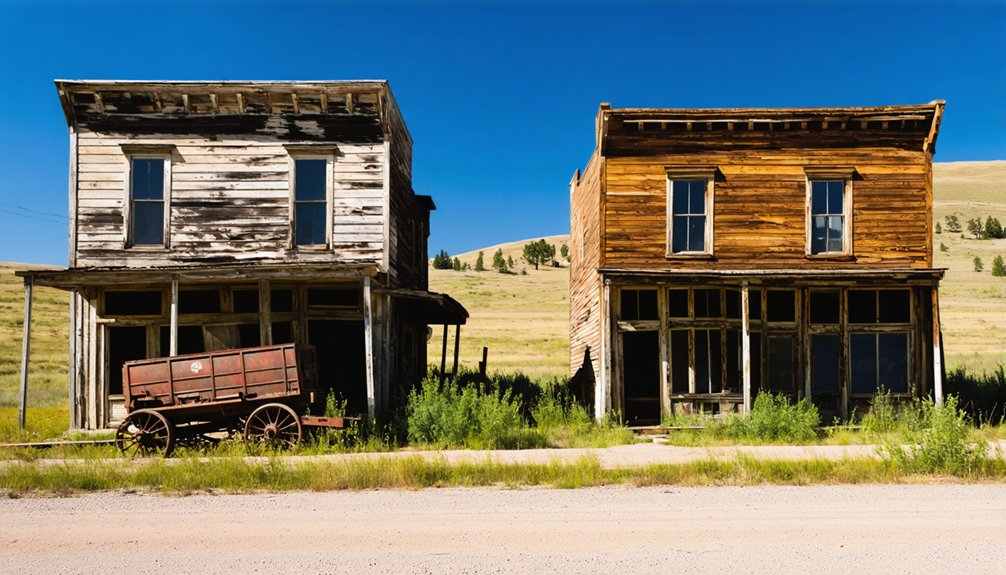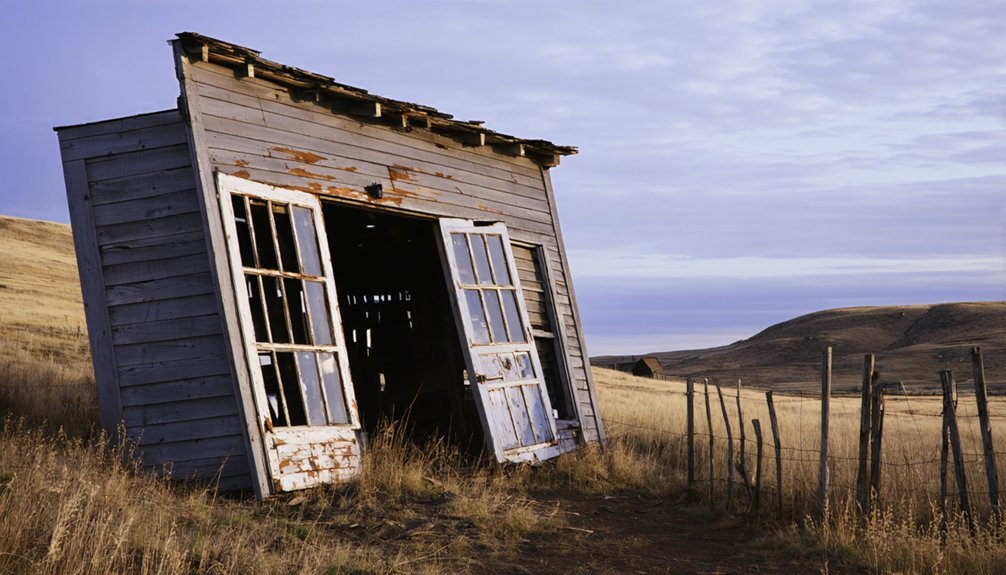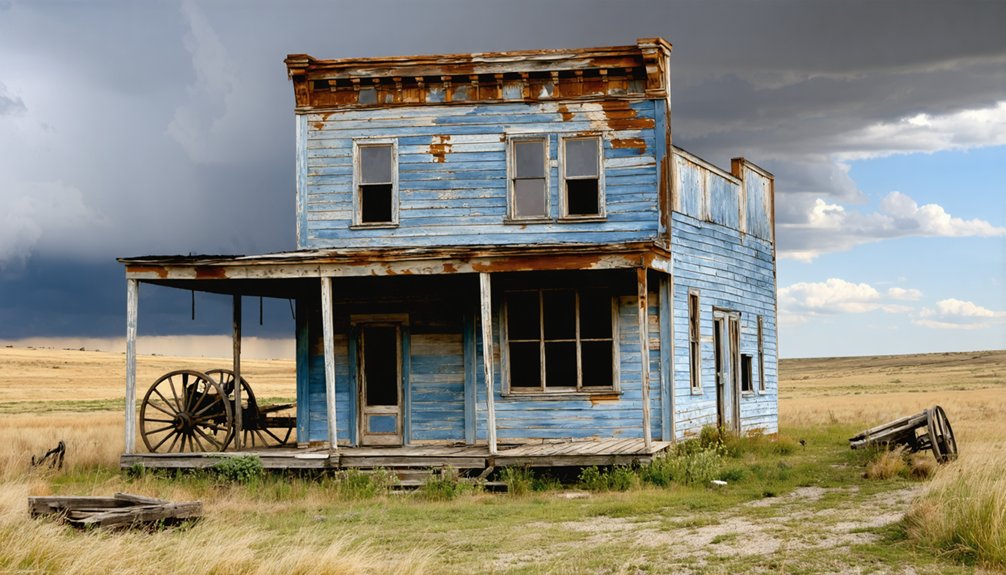You’ll find Hillside nestled in South Dakota’s Black Hills, where gold was first discovered in French Creek in 1874. This bustling mining settlement thrived through the late 1800s, boasting 15 saloons along its Main Street and a diverse community of Norwegian, German, and Russian immigrants. The town’s fortunes declined after the Great Depression hit in 1929, but today you can explore its weathered foundations and original railroad station, where echoes of America’s frontier spirit linger.
Key Takeaways
- Hillside began as a gold rush settlement in 1876 following gold discoveries in French Creek, later experiencing tin mining prosperity in 1883.
- The town featured 15 saloons along Main Street and housed diverse immigrant groups from Norway, Germany, and Russia during its peak.
- Mining operations, including the Homestake Mine, drove the economy until the Great Depression caused mass exodus and eventual abandonment.
- Historic remnants include building foundations, the original railroad station, and mining equipment from the town’s industrial past.
- Now a ghost town, Hillside offers self-guided walking tours and preservation efforts to showcase South Dakota’s mining heritage.
The Rise and Fall of a Mining Community
When gold was discovered in French Creek in 1874, just 13 miles south of what would become Hill City, it sparked a transformative rush that would forever shape South Dakota’s Black Hills region.
The discovery of gold at French Creek in 1874 ignited a wave of fortune-seekers that reshaped the Black Hills forever.
You’d have found prospectors flocking to the area, employing basic mining techniques like placer mining in the creeks and hills, though these deposits quickly ran dry.
While Hill City emerged as one of the territory’s first gold rush settlements in 1876, it couldn’t sustain its initial boom.
The community’s resilience would be tested as richer strikes in Deadwood lured away its population by the late 1870s.
Yet Hill City refused to fade entirely – the discovery of tin in 1883 breathed new life into the town, attracting English investors and bringing railroad connections by 1890, helping this determined settlement adapt and survive.
Located at an elevation of 4,984 feet, the town’s high-altitude mining operations presented unique challenges for early prospectors.
The area’s mining legacy included the legendary Homestake Mine discovery in 1876, which went on to produce a remarkable 10% of the world’s gold supply over its 125-year operation.
Life in Early Settlement Days
Though life in early Hillside centered on mining prospects, the settlement quickly developed into a vibrant frontier community shaped by diverse immigrant groups from Norway, Germany, and Russia.
You’d have found a bustling town where community dynamics revolved around the mile-long Main Street, featuring 15 saloons that served as social hubs for miners and settlers alike.
The cultural influences of immigrant groups merged with frontier life, creating unique customs and traditions.
You’d have seen modest sandstone homes dotting the landscape, while churches anchored both ends of town.
Despite harsh conditions and limited services, settlers adapted through mutual aid and determination.
When the Chicago, Burlington, and Quincy Railroad arrived in 1893, it brought new opportunities for trade and growth to the developing settlement.
The establishment of a post office, hotels, and various trades demonstrated the town’s evolution from a mining camp into a proper settlement where people carved out their lives in the Dakota Territory.
The discovery of Deadwood Formation gold in nearby areas fueled the town’s rapid growth and attracted prospectors from across the region.
Mining Operations and Economic Growth
The economic pulse of Hillside quickened with the broader mining boom that swept through the Black Hills region in the late 1800s.
While specific records of Hillside’s mining operations remain scarce, you’ll find that the town likely benefited from the region’s diverse mining techniques, including placer and hard-rock mining that dominated the era.
The development of mining infrastructure transformed the Black Hills, bringing railroads, mills, and the promise of economic sustainability to remote settlements. The area’s mining operations often utilized cyanide extraction methods to process gold ore more efficiently.
Like many towns of its time, Hillside’s fortunes were tied to the mining industry that defined South Dakota’s growth.
Though modern environmental regulations didn’t exist then, the mining operations of that period laid the groundwork for the region’s development, even as they left behind a complex legacy of both prosperity and environmental challenges.
Natural Resources That Shaped Hillside
You’ll find Hillside’s earliest prosperity rooted in the vast mineral wealth of its metamorphic and igneous bedrock, where gold deposits formed in veins and shear zones over 1.6 billion years ago.
The region’s rich natural bounty extended beyond precious metals to include valuable timber resources from the surrounding Black Hills forests, which provided essential materials for mining operations and construction. Located within the Trans-Hudson orogen, this geological setting influenced the formation and accessibility of the area’s mineral deposits.
These resources drew prospectors and entrepreneurs throughout the late 1800s, leading to the establishment of sawmills and coal mining operations that sustained Hillside’s growth during its peak years. The area’s geological heritage aligns with South Dakota’s broader mining history, particularly the Homestake Mine production which yielded over 31 million ounces of gold by 1976.
Mining’s Early Economic Impact
During Hillside’s formative years, rich mineral deposits in the Black Hills region shaped the town’s economic destiny alongside neighboring communities. The discovery of gold, silver, and other valuable minerals sparked a rush of prospectors who’d transform the landscape with their panning and hydraulic mining operations. The Homestake Mine alone generated over $720 million in gold throughout its century of operations. Miners utilized hand drilling equipment to extract precious metals before steam-powered tools arrived around 1900.
You’ll find this mining heritage deeply woven into the area’s economic legacy, as boomtowns like Deadwood emerged and flourished.
The surge of mining activity brought significant capital investment and infrastructure development to the region. You can trace how railroads and roads were carved through the terrain, connecting Hillside to a network of bustling mining operations.
The industry didn’t just extract wealth from the earth – it created thousands of jobs and attracted entrepreneurs who’d establish the foundations of local commerce and community growth.
Gold Rush Resource Timeline
Mining’s economic impact on Hillside became more focused when gold discoveries transformed the Black Hills region in 1874.
You’ll find that Custer’s expedition sparked the first wave of prospecting methods, with miners panning scattered placer deposits in streambeds throughout the area.
The discovery led to extensive development, particularly with the Homestake Mine, which produced over 40 million ounces of gold during its 125-year operation.
Timber and Coal Operations
The timber industry laid the cornerstone of Hillside’s early development, beginning with Custer’s pioneering sawmill in 1875.
You’ll find that timber harvesting quickly expanded throughout the Black Hills, as demand for lumber surged with the region’s settlement and mining operations.
Homestake Mining Company emerged as the dominant force in local timber sales, operating a cutting-edge sawmill in Spearfish by 1940.
As you explore Hillside’s history, you’ll discover that ponderosa pine was the lifeblood of local logging operations, yielding over 5,000 board feet per 1,000 cubic feet of log volume.
While coal exploration didn’t play a significant role in Hillside’s story, the timber industry provided essential jobs and economic stability until increased federal regulation and sustainable forestry practices reshaped the landscape.
Transportation and Railroad Connections
You’ll find Hillside’s early development was heavily influenced by the railroad connections that crisscrossed the Black Hills region in the late 1800s.
The Chicago, Burlington and Quincy Railroad’s Keystone Branch, completed in 1900, provided vital transportation links for the area’s mining and timber operations, transforming Hillside from an isolated outpost into a connected frontier community.
These rail connections allowed the town’s natural resources to reach broader markets while bringing in essential supplies and workers, though the same rail lines that built the town would later contribute to its decline when they were abandoned after World War II.
Railroad Impact on Settlement
As railroads pushed through the Black Hills in the late 1800s, Hillside’s connection to the Chicago, Burlington & Quincy Railroad’s High Line transformed this remote settlement into a vibrant hub of commerce and communication.
The railroad expansion brought unprecedented growth, connecting the town to broader markets and facilitating the movement of essential goods, equipment, and people.
You’d find the depot bustling with activity as it served as the heart of community connectivity. It’s where you could send telegrams, ship packages, and catch up on the latest news from arriving newspapers.
The railway didn’t just move tin, timber, and mining equipment – it brought new settlers, visitors, and opportunities. Rail sidings with grain elevators and warehouses helped local producers reach distant markets, cementing Hillside’s role in the region’s economic development.
Early Transportation Routes
Long before the railroad transformed Hillside’s landscape, pioneering settlers relied on a network of rugged freight trails and wagon roads to connect with the outside world. You would’ve witnessed freight challenges as oxen-drawn trains labored across 200-mile stretches, taking a full month for one round trip.
Trail construction often depended on local communities pooling resources to improve these essential lifelines.
Key transportation features you’d have encountered:
- Freight trains with up to 30 wagons and 250 oxen traversing the Fort Pierre to Deadwood trail
- Mule teams offering faster but pricier hauling services between settlements
- Transfer points where steamboat cargo shifted to overland transport at Fort Pierre
The Chamberlain Road’s improvement in 1882 marked a turning point, though stubborn bottlenecks persisted during summer freight rushes.
Daily Life in a Black Hills Mining Town

Life in a Black Hills mining town revolved around the demanding rhythm of mineral extraction, where dawn-to-dusk labor shaped the fabric of daily existence.
You’d rise early to descend into the depths, extracting ore alongside hundreds of fellow miners, always aware that mining accidents could strike without warning. Mercury exposure and cave-ins were constant threats in these dangerous underground workplaces.
After your shift, you’d find comfort in the town’s vibrant social scene. Community gatherings at saloons and gaming halls offered relief from the day’s toil. You might catch a traveling theater troupe’s performance or join celebrations at the local church.
While living conditions were basic – often just a cramped cabin or tent with minimal amenities – the sense of shared purpose and adventure made up for the hardships you’d face daily.
The Great Depression’s Impact
The prosperous days of Black Hills mining communities came to an abrupt halt when the Great Depression struck in 1929.
You’ll find that Hillside, like many mining towns, faced unprecedented challenges as bank failures and crop disasters compounded the economic devastation. The town’s survival hinged on federal assistance programs and remarkable community resilience.
With banks collapsing and crops failing, Hillside’s mining community survived through government aid and unwavering local determination.
During these trying times, mining families adapted through:
- Sharing limited resources and supporting neighbors in need
- Cultivating victory gardens and bartering goods
- Participating in government work programs for essential income
Those who remained in Hillside witnessed the gradual exodus of their neighbors seeking opportunities elsewhere.
While some towns managed to diversify their economies, Hillside’s dependence on mining ultimately led to its abandonment, transforming it into one of the Black Hills’ haunting ghost towns.
Architectural Remnants and Structures

You’ll find several remnants of Hillside’s mining operations still standing against the Black Hills backdrop, including weathered ore processing facilities and equipment foundations.
The old residential area reveals scattered building foundations where miners and their families once made their homes, with stone walls and cellar holes marking where modest houses stood.
The original railroad station, though now in ruins, remains one of the most striking features of the ghost town, with its crumbling platform serving as a reminder of the crucial rail connection that once brought life to this remote settlement.
Mining Structures Still Standing
Scattered across Hillside’s rugged terrain, mining structures from its prosperous past still stand as weathered sentinels of the town’s golden age.
You’ll find remarkable examples of early mining technology in the partially collapsed shaft houses and adjacent hoist structures that once lowered miners 150 feet into the earth’s depths.
The ghost town preservation efforts have left behind fascinating industrial remnants:
- Stamp mills with their massive foundations, particularly visible at the Spokane mine site, where ore crushing operations once thundered through the valley
- Original hoist houses with visible cable paths and winch machinery that controlled the miners’ descent into the depths
- Stone and timber shaft houses, though deteriorating, still showcase the period’s distinctive mining architecture and engineering ingenuity
Residential Building Foundations Remain
While most structures have succumbed to time’s ravages, numerous stone and brick foundations remain scattered throughout Hillside’s residential district, offering glimpses into the town’s bustling frontier life.
You’ll find these architectural remnants revealing both simple miners’ cabins and more substantial homes, with foundation preservation varying based on their exposure to the harsh Black Hills elements.
As you explore the residential areas, you’ll spot telltale chimney bases and cellar holes among the foundations, hinting at the daily lives of Hillside’s former inhabitants.
The foundations’ sizes and arrangements showcase late 19th-century building patterns, and their varying materials – from rough-cut stone to early concrete – demonstrate the architectural significance of this frontier settlement.
Occasional artifacts nestled among the ruins provide further connection to the town’s pioneering past.
Original Railroad Station Ruins
Beyond the residential foundations lies the heart of Hillside’s transportation legacy – the original railroad station site. You’ll find scattered railroad artifacts along the old grade where trains once delivered essential supplies to this bustling Black Hills community.
While the wooden depot architecture has long since vanished, the site reveals clues about this once-crucial transportation hub.
As you explore, you’ll notice:
- Stone foundations and concrete footings that once supported the station’s walls
- Depressions from rotted railroad ties marking the original track alignment
- Rusted spikes and rail fragments scattered along the former right-of-way
The station served as Hillside’s lifeline to the outside world, where locals gathered to receive mail, ship mining resources, and welcome newcomers.
Though the building’s gone, these remnants tell the story of the town’s railroad era.
Notable Residents and Their Stories

During Hillside’s brief but vibrant history, the town’s notable residents shaped its character through their pioneering spirit and determined efforts.
Pioneer families endured harsh conditions in makeshift homes near mining shafts, while legendary miners who struck rich veins quickly rose to local prominence. You’ll find stories of both triumph and tragedy, from successful entrepreneurs who ran multiple operations to those who lost their lives in mine collapses or disease outbreaks.
The town’s social fabric was woven by diverse characters – from saloon owners who earned the town its “mile of Hell” reputation to religious leaders who established churches at opposite ends of town.
School teachers and postmasters maintained order, while traveling entertainers added color to Hillside’s already vibrant frontier atmosphere.
Modern-Day Ghost Town Tourism
Today’s visitors to Hillside experience a stark contrast to the bustling frontier town once filled with those colorful characters and determined pioneers.
As part of South Dakota’s growing ghost town preservation movement, you’ll find Hillside embracing sustainable tourism practices while maintaining its authentic charm.
When you explore Hillside, you’ll discover:
- Self-guided walking tours that protect fragile structures while sharing the town’s rich history
- Photography opportunities capturing the hauntingly beautiful decay of frontier architecture
- Local artisans selling handcrafted items inspired by the town’s mining heritage
You’re part of a new generation of travelers seeking authentic connections to America’s past.
Tourism sustainability efforts guarantee you’ll experience Hillside’s genuine character while protecting it for future history enthusiasts, photographers, and those drawn to the quiet whispers of forgotten times.
Frequently Asked Questions
Are There Any Paranormal Activities or Ghost Sightings Reported in Hillside?
You won’t find documented ghost encounters or spectral sightings, as no official records exist. While many Black Hills ghost towns have paranormal claims, there’s no evidence of supernatural activity at this location.
What Happened to the Artifacts and Personal Belongings Left Behind?
While you’d expect treasures galore, most artifacts and personal belongings have vanished through time, looting, and decay. What remains holds historical significance in private collections or simply crumbles into dust.
Can Visitors Legally Take Souvenirs From the Ghost Town Site?
You can’t legally take souvenirs due to strict historical preservation regulations. While you’re free to explore, all artifacts must remain untouched to protect the site’s heritage for future generations.
Are There Any Surviving Maps Showing Original Property Boundaries?
You’ll find fragmentary property boundaries in USGS maps and mining claim records, though historical landmarks aren’t clearly marked. Be cautious, as property disputes can arise from incomplete documentation.
Did Any Native American Tribes Inhabit This Area Before Mining Began?
While written records aren’t extensive, you’ll find the area was historically significant to Native tribes including the Lakota Sioux, who considered the Black Hills sacred land before miners arrived in the 1870s.
References
- https://www.sdhspress.com/journal/south-dakota-history-2-2/some-black-hills-ghost-towns-and-their-origins/vol-02-no-2-some-black-hills-ghost-towns-and-their-origins.pdf
- https://www.sdpb.org/rural-life-and-history/2023-08-21/some-black-hills-ghost-towns-and-their-origins
- https://www.powderhouselodge.com/black-hills-attractions/fun-attractions/ghost-towns-of-western-south-dakota/
- https://www.youtube.com/watch?v=Glucs_Rq8Xs
- https://gracefultouch.org/latest/news/hill-city-history/
- https://koa.com/campgrounds/hill-city/blog/the-history-of-hill-city-south-dakota_d2f2a510-44d2-4e37-80e2-e58db6751b04/
- https://en.wikipedia.org/wiki/List_of_ghost_towns_in_South_Dakota
- https://www.southdakotamagazine.com/galenas-ghosts
- https://mad-peak.com/blog-posts-and-info/f/galena-south-dakota-adventure-into-a-wild-west-ghost-town
- https://en.wikipedia.org/wiki/Black_Hills_gold_rush



